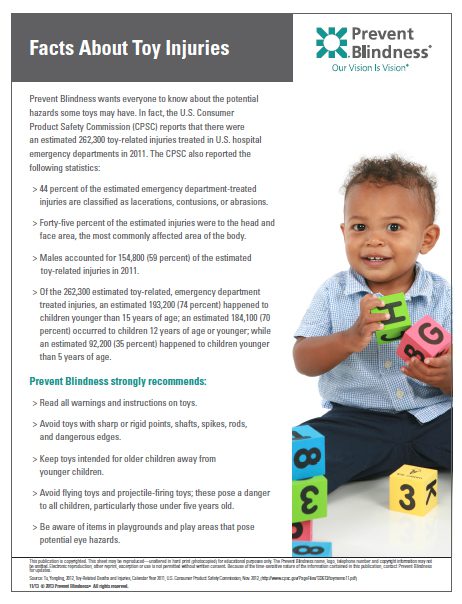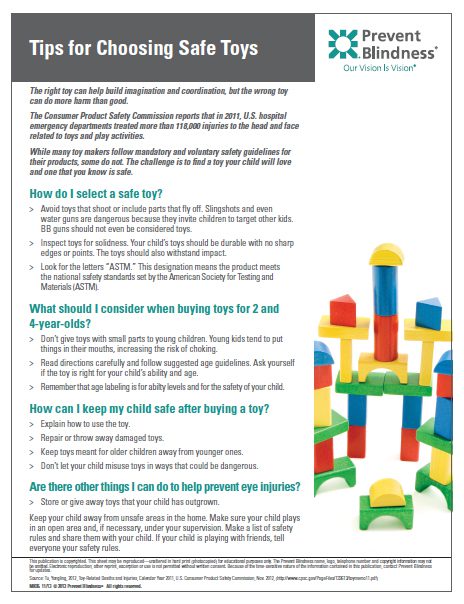Keep Holidays Bright When Shopping This Year
More Than 262,000 Were Treated in U.S. Hospital Emergency Departments in 2011 from Toy-related Injuries
CHICAGO (Nov. 14, 2013) – As widely reported, an increasing number of major retailers across the country plan to open on Thanksgiving in order to give shoppers a jump on their holiday shopping. Combined with the popularity of online shopping, consumers can complete their lists earlier than ever. And, with Hanukkah beginning early as well, Prevent Blindness America, the nation’s oldest non-profit eye health and safety group, is providing tips to gift-givers to make sure all gifts are the safe, especially those intended for children.
|
Download the Facts About Toy Injuries Fact Sheet
|
Download the Tips for Choosing Safe Toys Fact Sheet
|
In 2011, the U.S. Consumer Product Safety Commission (CPSC) estimated that hospital emergency rooms across the country treated 262,300 toy-related injuries. And, 74 percent of those injuries were to children under the age of 15. In fact, more than 92,000 were to those under 5 years of age.
Because the most commonly injured part of the body is the head and face area, Prevent Blindness America has declared December as Safe Toys and Gifts Month in an effort to help adults make the best decisions on how to keep the holiday season joyful for everyone. The group is offering toy-buying and gift-giving tips to anyone planning to purchase a gift for a child this year.
Prevent Blindness Americasuggests that before purchasing a toy:
- Read all warnings and instructions on the box.
- Ask yourself or the parent if the toy is right for the child's ability and age.
- Avoid purchasing toys with sharp or rigid points, spikes, rods, or dangerous edges.
- Check the lenses and frames of children's sunglasses; many can break and cause injuries.
- Buy toys that will withstand impact and not break into dangerous shards.
- Look for the letters ASTM. This designation means the product meets the national safety standards set by the American Society for Testing and Materials (ASTM).
- Avoid toys that shoot or include parts that fly off.
- Gifts of sports equipment should always be accompanied by protective gear (such as a basketball along with eye goggles or a face guard with a new batting helmet for baseball or softball).
- Don’t give toys with small parts to young children. Young kids tend to put things in their mouths, increasing the risk of choking. If the part of a toy can fit in a toilet paper roll, the toy is not appropriate for children under the age of 3.
- Do not purchase toys with long strings or cords, especially for infants and very young children as this can become wrapped around a child’s neck.
- Always dispose of uninflated or broken balloons immediately. According to the CPSC, more children have suffocated from them than any other type of toy.
“To help keep the holidays festive and bright, we hope all gift-givers will take a moment to make safety the top priority when considering gifts,” said Hugh R. Parry, president and CEO of Prevent Blindness America. “We at Prevent Blindness America also wish everyone happy holidays and a safe and Happy New Year!”
For more information on safe toys and gifts for children, including the PBA Safe Toys Check List, please preventblindness.org/safe-toy-checklist, or call Prevent Blindness America at (800) 331-2020.
Download the Safe Toys and Gifts press release.


